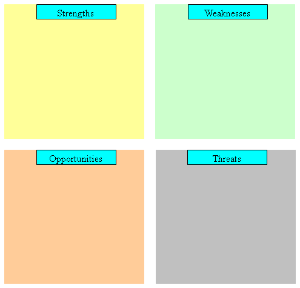Leadership - SWOT analysis
SWOT analysis
What is it?
These can then be assessed via the SWOT technique, which is common to managing projects, to identify where the team can consolidate strengths, improve weaknesses, take advantage of opportunities and minimise threats.
SWOT
Stands for Strengths, Weaknesses, Opportunities and Threats.
The SWOT analysis can be carried out at varying levels.
- To examine a vision.
- Specific strategy
- Take a look at the team
- Specific problem etc
It lends it self to easy adaptation.
When you tackle a SWOT analysis you want to focus on the key or ‘strategic’ issues for the level you are at.
If you don’t, you will run the risk of generating too much detail and being swamped with minor issues.
You are trying to maintain and build upon any Strengths.
Ideally, you must confront your Weaknesses honestly with a view to doing something about them.
You would like to take advantage of any Opportunities that may present themselves.
Tactics are required to minimise any threats to your vision, team performance or problem solving.
Having considered all of these the team should now be in a position to identify appropriate strategies, eliminate those that are unsuitable and agree the strategy.
When drawing up a strategy and finalising a schedule remember that what may work in one environment may fail in another.
The overall plan should not reflect a ‘glory or bust’ approach.
If the project is long break it down into parts that will show steady gains. This will improve morale.


